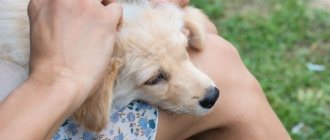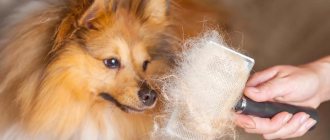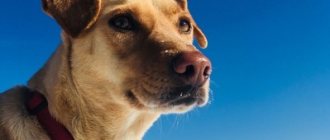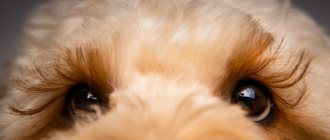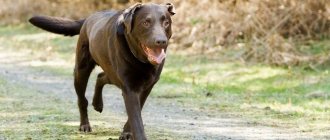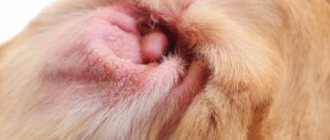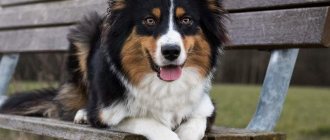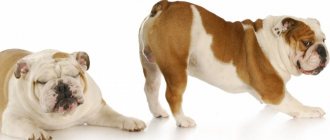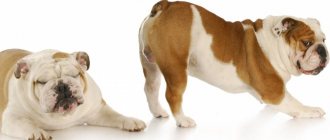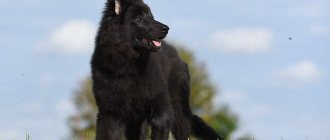Prolapse of hemorrhoids is a fairly common problem encountered in humans. It occurs due to a shift in the center of gravity to the pelvic area, which is typical for mammals that move on two limbs. Because of this, some owners doubt whether a dog can have hemorrhoids, or whether such a problem is completely alien to them.
Do dogs get hemorrhoids and what is it?
Hemorrhoids in dogs are a fairly rare phenomenon, accompanied by pathological dilation of the hemorrhoidal veins. This disorder occurs against the background of a slowing outflow of blood. Due to stagnation, the walls of the veins stretch and become thinner. Accumulating blood provokes the development of inflammation.
Dilated veins become deformed and form nodes, which eventually fall out of the anus. The swollen tissues cannot withstand the pressure and rupture, opening bleeding.
Prevention
To avoid the development of this unpleasant disease in your pet, you must follow simple preventive measures:
- Feed your pet correctly with the addition of foods rich in fiber, use vitamin and mineral supplements;
- Walk the animal for a long time in the fresh air;
- Carry out preventive deworming of your pet;
- Bring your animal to the clinic for annual examinations with blood and urine tests;
- If you notice the first symptoms of the disease, contact a veterinarian.
Similar articles:
- Gum inflammation in dogs
- Intoxication in dogs
- Furunculosis in dogs
- Toxocariasis in dogs
- Bursitis in dogs
- Why does a dog have red eyes?
Reasons for the development of the disease
Hemorrhoids in dogs occur due to congestion in the lower part of the pelvis, reducing the tone of the blood vessels. Such violations are associated with the presence of the following factors:
- lack or excess of physical activity;
- advanced helminthiasis;
- frequent pregnancies that increase pelvic pressure;
- malignant neoplasms in the intestines;
- regular constipation and intestinal obstruction;
- obesity, which causes vein blockage;
- lack of vitamins and minerals associated with the use of cheap feed or an incorrectly selected diet (lack of balance of KBJU);
- pathologies of the genitourinary system (ulcerative urolithiasis, cystitis);
- dehydration.
The risk group includes older pets and decorative breeds (Yorkies, Pekingese, Toy Poodles) that rarely go outside. Pathology in puppies is less common - in their case, the lack of vitamins necessary for the formation of bones and muscles is to blame.
Symptoms that should alert you
Symptoms and treatment of hemorrhoids in dogs depend on its type, course and stage of development. At the very beginning, severe itching occurs, so the pet anxiously licks or rubs its anus on surrounding objects. Over time, the signs become more alarming:
- dry and hard feces mixed with mucus and blood clots;
- redness and swelling of the anus;
- pain during bowel movements, accompanied by whining or squealing;
- unusually wide stance of the paws while walking.
In more severe cases, prolapse of hemorrhoids is noted, which can be seen in detail in the photo. After damage to the venous walls, the symptoms are supplemented by severe bleeding and paleness of the mucous membranes due to anemia.
Briefly about the main thing
- Hemorrhoids are a rare disease in dogs, but they can be caused by poor diet and little physical activity.
- Hemorrhoids can be confused with intestinal diseases.
- The disease causes discomfort to the animal, and if not treated promptly, serious complications can occur.
- Treatment should be prescribed by a veterinarian, depending on the stage of the disease.
- The animal's diet should be radically changed.
- The fourth stage of hemorrhoids can only be treated surgically.
Stages of disease development
The disease develops progressively and goes through 4 stages of development. They all have their own characteristic symptoms:
- In the first stage, only itching appears. The owner can detect a violation by too frequent licking and riding on the butt. Redness and inflammation of the mucous membrane will only be noticeable to a veterinarian.
- In the second stage, acute pain is added to the itching. Fecal masses moving through the intestine touch the inflamed veins, complicating emptying.
- At the third stage, scarlet blood appears in the feces, and some nodes fall out.
- In the fourth stage, small amounts of blood are replaced by heavy bleeding from the anus. Without timely help, the pet risks dying from anemia.
If you notice at least one of the alarming symptoms, be sure to seek help. Many of the symptoms are similar to other pathologies, so before starting treatment you need to make sure of the exact cause of the ailment.
Diagnostic procedures
Diagnosis of hemorrhoids in dogs includes external examination of the anus and its palpation. If all nodes are out of sight, then the rectum is examined from the inside. To determine concomitant diseases, you will need to undergo a series of tests.
What tests will the doctor take?
The rate of blood clotting is determined using a coagulogram - a comprehensive study of a venous blood sample. To exclude parasitic infestation, a stool test is performed, and an intestinal biopsy is performed to exclude neoplasms.
What can be confused with hemorrhoids in dogs?
The problem with hemorrhoidal veins in four-legged pets is a real rarity. For this reason, it is important to make sure that the symptoms that arise do not indicate similar diseases:
- helminthiases;
- anal fissures;
- hernia or prolapse of the rectum;
- inflammation of the paraanal glands;
- paraproctitis;
- neoplasms in the rectum;
- ulcerative colitis.
Do not rush to draw conclusions before completing all the necessary research. In most cases, the cause of the malaise lies in one of the listed pathologies.
general characteristics
The lower part of the rectum is surrounded by a network of hemorrhoidal veins or cavernous bodies, which cover its entire length. Cavernous bodies are formations that combine veins, arteries and connective tissue that prevents their excessive expansion. When filled with blood, they ensure the functioning of the sphincter, which closes the anus, holding feces.
Hyperplasia of the cavernous bodies leads to their varicose veins. In humans, this is facilitated by upright posture, since in this position, the veins of the lower body are constantly under severe stress. Dogs do not have such a predisposing factor. The question arises: do dogs get hemorrhoids?
For a long time it was believed that dogs do not suffer from this disease. But, recently, hemorrhoids, although rarely, are diagnosed in dogs. When making a diagnosis, it is very important to correctly differentiate it from other diseases of the rectum, since much more often animals suffer from its prolapse, inflammation of the paraanal glands and similar ailments.
Procedures and treatments
After diagnosis, the veterinarian will definitely tell you how to treat hemorrhoids in a dog, based on its stage. Available treatment methods include taking medications and folk remedies, administering enemas and taking healing baths. Surgery is used only in extreme cases, when other methods do not give the desired effect.
Drug therapy and folk remedies
In the first two stages, treatment of hemorrhoids in dogs is carried out at home. To improve the patient’s well-being, use:
- venotonics (Venarus, Detralex), which promote healthy blood vessels and prevent stagnation of venous blood;
- antiseptic ointments and sea buckthorn oil necessary for treating an inflamed anus;
- laxatives (Guttalax, Duphalac, castor oil), facilitating bowel movements;
- hemostatic suppositories (hemostatic suppositories).
If the disease is advanced, hospitalization may be required. Acute pain is relieved with anesthetics, and vasoconstrictor and hemostatic drugs are used to stop bleeding. Due to the high probability of a secondary infection, the four-legged patient is prescribed antibiotics.
The use of traditional medicine is permissible as an auxiliary therapy in consultation with the attending physician. Drinking plenty of yarrow infusions and special herbal baths help well.
Administration of an enema
You can make defecation easier not only by taking laxatives orally, but also by giving an enema. The effect of this procedure appears within 15 minutes. If the pet has been patient for a long time, then it can go to the toilet immediately after the procedure.
Most of the laxative solution should be water, and the rest should be Vaseline, chamomile decoction, fish oil, glycerin or soap solution. The amount of liquid depends on the weight of the pet:
- 50 ml – small breed dogs up to 10 kg;
- 200 ml – medium-sized breeds from 11 to 25 kg;
- 500 ml – large breeds from 26 to 44 kg;
- 1000 ml – giant breeds weighing more than 44 kg.
Puppies are allowed no more than 1 tablespoon of water without additional impurities. Due to the large number of contraindications, including anal bleeding, the procedure is carried out only in consultation with a veterinarian.
If the injected liquid flows out of the anus and does not pass inside, you must urgently stop the procedure and seek help from a veterinary clinic. The problem that has arisen indicates intestinal obstruction, so further actions may result in intestinal rupture.
Special baths
After walking, it is recommended to wash the inflamed anus with a cool decoction of yarrow, St. John's wort, calendula, burdock root and sage. Such herbal baths have the following benefits:
- eliminate swelling;
- reduce nodules;
- relieve pain;
- reduce the amount of bleeding.
The temperature of the solution should differ from the pet’s body temperature by 3-4 degrees. For the effectiveness of the procedure, it is recommended to measure the indicator with a thermometer.
Surgical intervention
Surgery is resorted to in the absence of a positive effect from taking medications and in advanced forms of the disease. Surgical intervention is indicated for animals with the following symptoms:
- heavy bleeding;
- large nodes;
- extensive swelling.
The operation is performed under general anesthesia. The surgeon excises part of the rectal tissue located above the damaged area. The existing nodules are tied with a thread at the base, promoting their independent death due to lack of blood. A faster method is cryodestruction, that is, exposure to liquid nitrogen.
Diet is an important condition for recovery
No less important is a therapeutic diet, which involves a revision of the diet. With its help, it is necessary to stabilize the consistency of feces and reduce the load on the inflamed intestines.
What products can be consumed and in what form?
To recover, your pet will need a lot of fiber and easily digestible foods. The basis of the diet should be lean meat (veal, chicken) and offal. Vegetables should be boiled or steamed.
Porridge can and should be cooked in light meat broth. Suitable cereals include rice, buckwheat and oatmeal. They are enriched with all necessary vitamins and have a beneficial effect on the circulatory system.
From fermented milk products, it is recommended to give fresh sour cream, cottage cheese and kefir. Choose brands with low fat content and a short shelf life, eliminating the addition of preservatives.
To improve digestion, it is recommended to add bran or probiotics to prepared meals. The food itself should be served in small pieces, as otherwise it may damage the mucous membranes.
Forbidden food
It is necessary to exclude any food from the human table from the diet: sweets, baked goods, smoked foods, pickles, spices, canned food and fried foods. As for cereals, you should avoid millet, semolina and corn porridge.
Until recovery, your pet should not be given any bones (even the shoulder blade and sternum), since these products are difficult to digest.
Industrial feed
If a dog is diagnosed with hemorrhoids, then dry food from a veterinary line intended for the treatment of gastrointestinal pathologies is suitable for it. The brands Eukanuba, Hill's and Royal Canin have such diets. To ensure comfortable digestion of dry kibble, your pet should always have access to fresh water.
Dietary recommendations
A large amount of water and liquid food is introduced into the animal’s diet, and solid, hard-to-digest and fatty foods are excluded. Dry foods are replaced or “wetted” with water/broth.
What is possible?
- wet food;
- porridge;
- dairy products;
- pureed vegetables;
- lean beef;
- baby food;
- canned food
What's not allowed?
- bones;
- fatty meat (lamb, pork);
- cereals (not recommended);
- dry prepared food;
- highly salty and sweet foods.
Which food to choose?
Hill's foods: Prescription Diet Canine z/d, Prescription Diet i/d Canine Low Fat Original, Prescription Diet Canine d/d Salmon, Prescription Diet Canine i/d and others.
Royal Canin food: GASTRO INTESTINAL GI25, GASTRO INTESTINAL, FIBRE RESPONSE FR23, GASTRO INTESTINAL LOW FAT LF22, GASTRO INTESTINAL LOW FAT and others.
Food from Natura Pet Products, GO, Purina.
Before purchasing, you should study the composition of the food, take into account your pet’s taste preferences, age and physiological condition (digestive system disorders).
The foods listed above may not necessarily be suitable for your pet. The choice of food is strictly individual.

